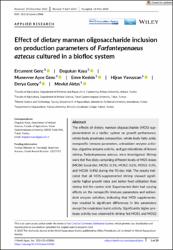| dc.contributor.author | Genç, Ercüment | |
| dc.contributor.author | Kaya, Doğukan | |
| dc.contributor.author | Genç, Münevver Ayçe | |
| dc.contributor.author | Keskin, Emre | |
| dc.contributor.author | Yavuzcan, Hijran | |
| dc.contributor.author | Güroy, Derya | |
| dc.contributor.author | Aktaş, Mevlüt | |
| dc.date.accessioned | 2025-01-17T11:33:53Z | |
| dc.date.available | 2025-01-17T11:33:53Z | |
| dc.date.issued | 2024 | en_US |
| dc.identifier.citation | Genc, E., Kaya, D., Genc, M.A., Keskin, E., Yavuzcan, H., Guroy, D., Aktas, M. (2024). Effect of dietary mannan oligosaccharide inclusion on production parameters of Farfantepenaeus aztecus cultured in a biofloc system. Journal of the World Aquaculture Society, 55 (5), art. no. e13086.
https://doi.org/10.1111/jwas.13086 | en_US |
| dc.identifier.issn | 0893-8849 | |
| dc.identifier.issn | 1749-7345 | |
| dc.identifier.uri | https://doi.org/10.1111/jwas.13086 | |
| dc.identifier.uri | https://hdl.handle.net/20.500.12508/3175 | |
| dc.description.abstract | The effects of dietary mannan oligosaccharide (MOS) supplementation in a biofloc system on growth performance, whole-body proximate composition, whole-body fatty acids, nonspecific immune parameters, antioxidant enzyme activities, digestive enzyme activity, and gut microbiota of brown shrimp, Farfantepenaeus aztecus, were investigated. Shrimp were fed five diets containing different levels of MOS doses (MOS0: basal diet, MOS1: 0.1%, MOS2: 0.2%, MOS3: 0.3%, and MOS4: 0.4%) during the 90-day trial. The results indicated that all MOS-supplemented shrimp showed significantly higher growth rates and better feed utilization than shrimp fed the control diet. Experimental diets had varying effects on the nonspecific immune parameters and antioxidant enzyme activities, indicating that MOS supplementation resulted in significant differences in the parameters except for respiratory burst activity. Significantly higher protease activity was observed in shrimp fed MOS1 and MOS2 diets compared with MOS0, MOS3, and MOS4 diets. Shrimps fed MOS2 and MOS3 diets had the highest lipase and amylase activities among all groups. Proteobacteria were the most abundant phylum in all groups and were higher at increasing MOS doses. In conclusion, these results suggest that supplementing the diet of brown shrimp in the biofloc system with 3 g kg−1 of MOS may improve production parameters. | en_US |
| dc.language.iso | eng | en_US |
| dc.publisher | Wiley | en_US |
| dc.relation.isversionof | 10.1111/jwas.13086 | en_US |
| dc.rights | info:eu-repo/semantics/openAccess | en_US |
| dc.subject | Diet | en_US |
| dc.subject | Food | en_US |
| dc.subject | Microbiota | en_US |
| dc.subject | Prebiotic | en_US |
| dc.subject | Shrimp | en_US |
| dc.subject.classification | Fisheries | |
| dc.subject.classification | Probiotic | |
| dc.subject.classification | Immune Response | |
| dc.subject.classification | Tilapia | |
| dc.subject.other | Pacific white shrimp | |
| dc.subject.other | Peels derived pectin | |
| dc.subject.other | Litopenaeus-Vannamei | |
| dc.subject.other | Disease resistance | |
| dc.subject.other | Growth-Performance | |
| dc.subject.other | Immune-Response | |
| dc.subject.other | Brasiliensis latreille | |
| dc.subject.other | Technology application | |
| dc.subject.other | Antioxidant status | |
| dc.subject.other | Water-Quality | |
| dc.subject.other | Artificial diet | |
| dc.subject.other | Bacterium | |
| dc.subject.other | Biota | |
| dc.subject.other | Crustacean | |
| dc.subject.other | Enzyme activity | |
| dc.subject.other | Food supplementation | |
| dc.title | Effect of dietary mannan oligosaccharide inclusion on production parameters of Farfantepenaeus aztecus cultured in a biofloc system | en_US |
| dc.type | article | en_US |
| dc.relation.journal | Journal of the World Aquaculture Society | en_US |
| dc.contributor.department | Deniz Bilimleri ve Teknolojisi Fakültesi -- Su Ürünleri Mühendisliği Bölümü | en_US |
| dc.identifier.volume | 55 | en_US |
| dc.identifier.issue | 5 | en_US |
| dc.relation.tubitak | 121O713 | |
| dc.relation.publicationcategory | Makale - Uluslararası Hakemli Dergi - Kurum Öğretim Elemanı | en_US |
| dc.contributor.isteauthor | Genç, Münevver Ayçe | |
| dc.contributor.isteauthor | Aktaş, Mevlüt | |
| dc.relation.index | Web of Science - Scopus | en_US |
| dc.relation.index | Web of Science Core Collection - Science Citation Index Expanded | |
















